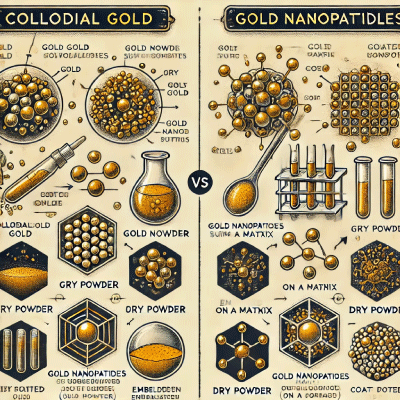Difference Between Colloidal Gold and Gold Nanoparticles: Properties and Applications
Colloidal gold and gold nanoparticles (GNPs) are closely related, but they refer to slightly different concepts depending on the context. Here’s a breakdown of their differences:
1. Terminology:
- Colloidal Gold: Traditionally refers to a suspension of tiny gold particles dispersed in a liquid, typically water. The term “colloidal” highlights the fact that the particles are small enough to remain suspended in the liquid rather than settling out. The size of these particles can vary, but they are typically in the nanometer range.
- Gold Nanoparticles (GNPs): Specifically refers to gold particles that are in the nanometer size range (1-100 nm). This term is used to describe the particles themselves, regardless of whether they are in a suspension (colloid) or not.

Image illustrating the difference between colloidal gold and gold nanoparticles, with labeled text for clarity. The visual shows both the liquid suspension of colloidal gold and the various forms of gold nanoparticles.
2. Size:
- Colloidal Gold: Historically, colloidal gold referred to larger particles in the range of tens to hundreds of nanometers. However, in modern usage, colloidal gold may refer to any gold particles in the nanoscale suspended in a liquid.
- Gold Nanoparticles: The term emphasizes particles that are in the nanometer scale, typically smaller than 100 nm. GNPs can be in colloidal suspension, or they can be isolated in dry form or embedded in matrices.
3. State of Suspension:
- Colloidal Gold: Always refers to gold nanoparticles in suspension within a liquid. Colloidal gold displays distinct optical properties, such as the red or pink color depending on particle size.
- Gold Nanoparticles: Can refer to gold particles in various forms, not necessarily suspended in a liquid. GNPs can be part of a powder, embedded in solid matrices, or coated on surfaces in addition to being in colloidal suspension.
4. Historical vs. Modern Usage:
- Colloidal Gold: This term has been used for centuries, dating back to alchemical practices and early chemistry. Colloidal gold solutions were known for their vivid colors and were used in ancient medicine and staining techniques.
- Gold Nanoparticles: A more modern term that has gained prominence with advances in nanotechnology. It is used in contemporary scientific and industrial contexts, emphasizing the use of gold at the nanoscale, particularly for applications like medical diagnostics, drug delivery, and catalysis.
5. Applications:
- Colloidal Gold: Historically, it was used in staining, artwork, and early medical applications. Today, colloidal gold still finds use in biology for labeling and microscopy.
- Gold Nanoparticles: GNPs are extensively used in modern science, particularly in medicine (e.g., for targeted drug delivery, cancer therapy, and imaging), electronics, and catalysis. Their applications have expanded with the advent of nanotechnology.
In summary, colloidal gold refers to gold nanoparticles suspended in a liquid, while gold nanoparticles can refer to gold particles of nanometer size in any context—whether suspended (colloidal), in solid form, or used in other materials or applications.
For more information, visit Nanopartz™ or contact us directly
By utilizing the comprehensive range of gold nanoparticle products from Nanopartz™, researchers and clinicians can push the boundaries of cancer treatment, improving outcomes and offering new hope to patients worldwide
Go here for Nanopartz Gold Nanoparticles

